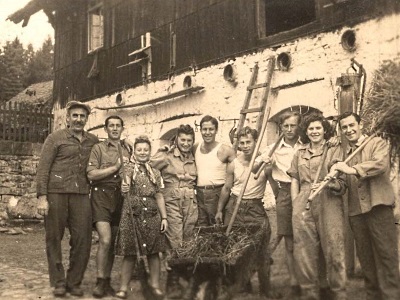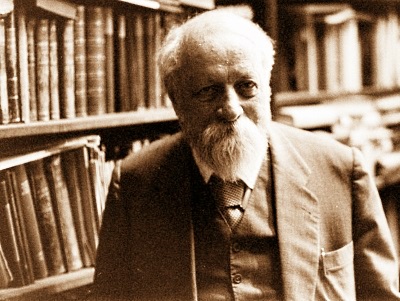This article is the first in a series on Eberhard Arnold and National Socialism.
Image: Nazi rally in Fulda, 1933.
Overview
“It is inherent in imitatio, in being Christlike, that we are ready for imprisonment and death,” Eberhard Arnold told members of the Rhön Bruderhof in March 1933.1 It was two days after Adolf Hitler’s address to the Reichstag and granting himself complete power, the moment Germany passed the point of no return to become a Nazi dictatorship. Eberhard spoke to his community about the challenges National Socialism would create for them as a result of their commitment to Jesus’ way of peace. Indeed, the fate of the entire Bruderhof in the years 1933–1937 serves as an example of Christian resistance and witness in this era of state violence.
The pacifism of the early Anabaptist movement was a core principle of the Bruderhof's identity. This meant that from the very beginning they distanced themselves from the regime, which quickly revealed its brutal, violent nature. The community members were also firmly opposed to the National Socialist racial principles. The Bruderhof thus stood in decisive opposition to National Socialist ideologies and expressed this antagonism in clear terms.
This resulted in a political confrontation that continued after Eberhard’s death in 1935. The entire period between 1933 and 1937 was characterized by suspicions that the Rhön Bruderhof was a communist association. This suspicion put the community in the crosshairs of state surveillance from the very beginning. There were raids by the SS and SA, the permit for the community’s school was withdrawn, and young men of military draft age had to leave the country to avoid conscription. Finally, the Rhön Bruderhof was dissolved by the German government and its members were expelled from Germany.
Literature
There has been increasing scholarly interest in this period of Bruderhof history.2 The following series of articles will provide an introduction to the era and what transpired, via the book An Embassy Besieged: The Story of a Christian Community in Nazi Germany (Eugene, OR: Cascade, 2010). The text brings together a wealth of primary sources – letters, meeting transcripts, historical publications – to form a detailed picture of the Bruderhof communities under Nazi rule. Its author, Emmy Barth, is a historian, archivist, and member of the Bruderhof. Alongside this book, she has also written No Lasting Home: A Year in the Paraguayan Wilderness (Walden, NY: Plough, 2009), which looks at the Bruderhof’s move from England to Paraguay during WWII.
Throughout this period, the Bruderhof regularly revisited the concept of embassy to understand their place in history. A quote from Eberhard Arnold opens the book and illustrates this:
The Apostle says that we are ambassadors of God, representing Christ, the messiah king, the regent of that last kingdom. When the British ambassador is in the British Embassy in Berlin, he is not subject to the laws of the German Reich. The grounds of the embassy are inviolable. In the residence of the ambassador, only the laws of the country he represents are valid.
We are ambassadors of the kingdom of God. This means that we do nothing at all except what the king of God’s kingdom would himself do for his kingdom. When we take this service upon ourselves we enter into mortal danger.3
Church communities are embassies of God’s kingdom. As such, Bruderhof members saw themselves as subject to God before they were subject to any human government like Hitler's. But with the Nazi regime’s devotion to squashing all internal opposition, these kinds of Christian commitments would not be without their consequences.
This is the first article in the series. The story proper begins in January 1933:
1. Overview and Literature
2. The Bruderhof under Nazi Rule: January–September 1933
3. Nazi Interest in the Bruderhof: October–December 1933
4. The Establishment of the Alm Bruderhof: 1934
5. Escape from Germany: 1935
6. Exiled to England: December 1935–1937
1. Meeting transcript, March 25, 1933 (EA 33/100), alternative translation quoted in Markus Baum, Against the Wind: Eberhard Arnold and the Bruderhof (Walden, NY: Plough, 2015), 175.
2. In English, see Baum, Against the Wind; Marjorie Hindley, “‘Unerwünscht’: One of the Lesser Known Confrontations with the National Socialist State, 1933–37,” German History 11:2 (1993): 207-221; James Irvin Lichti, “Serving Two Masters: The Nazi-Denominational Convergence on Church-State Relations,” in Houses on the Sand? Pacifist Denominations in Nazi Germany, 31–72 (New York: Peter Lang, 2008). In German, see Thomas Nauerth, Zeugnis, Liebe und Widerstand: Der Rhönbruderhof 1933–1937 (Paderborn, Germany: Schöningh, 2018 – English translation forthcoming); Imanuel Baumann, Loyalitätsfragen: Glaubensgemeinschaften der täuferischen Tradition in den staatlichen Neugründungsphasen des 20. Jahrhunderts (Göttingen: V&R Unipress, 2021). For more sources, see our bibliography page.
3. Meeting transcript, August 3, 1934 (EA 255), cited in Barth, Embassy Besieged, vii.


